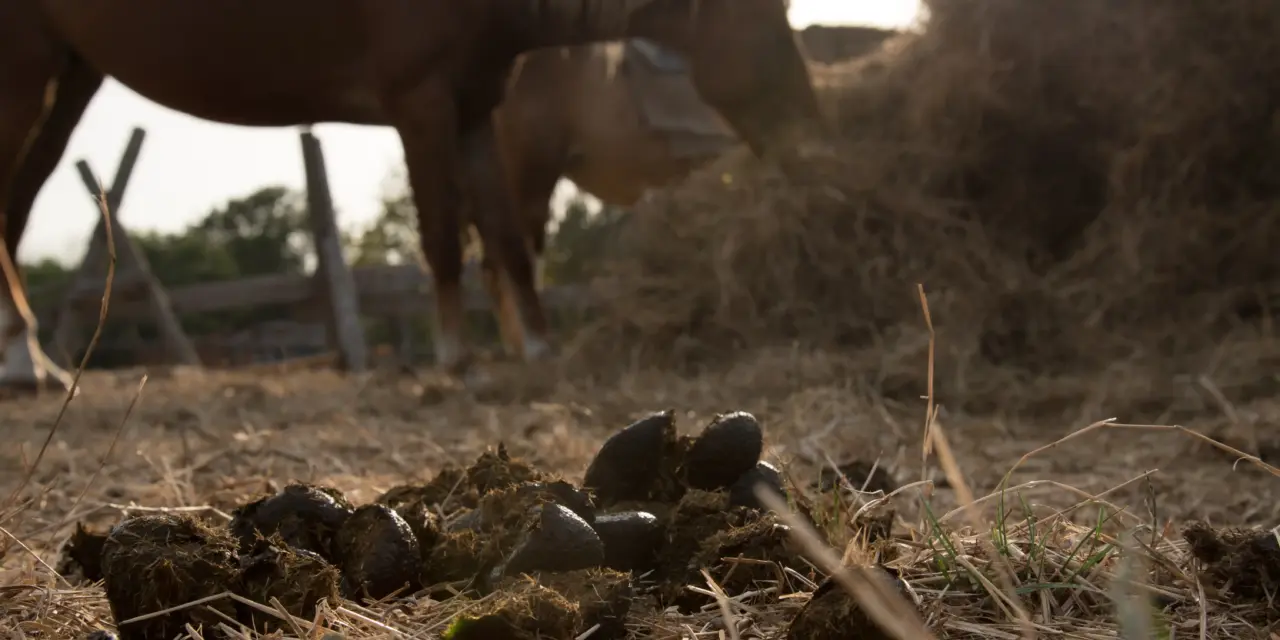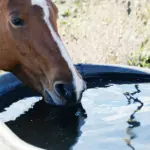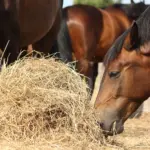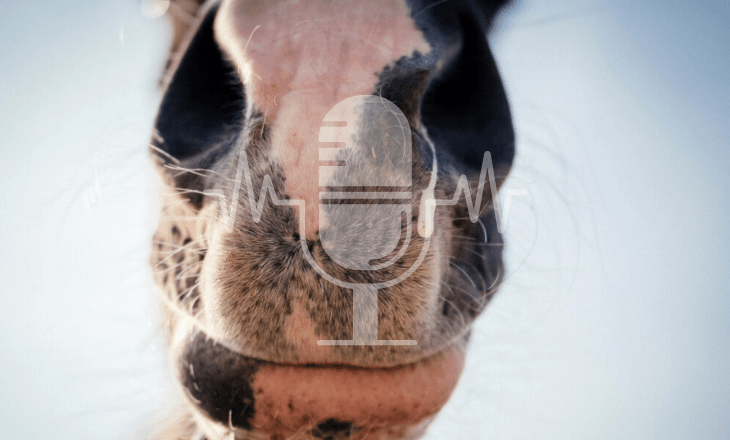Key Points at a Glance
- Different levels of automation: from simple scraper systems and vacuum set-ups to fully automated cleaning robots.
- High investment cost: systems range from around £5,000 for simple scraper set-ups to over £100,000 for full vacuum installations.
- Structural requirements are key: hard-surfaced flooring, adequate headroom, and a suitable stable layout are usually necessary.
- Maintenance-intensive: complex systems require regular professional servicing and often suffer frequent downtime.
- Limited suitability for horses: many systems are designed for cattle housing and are only of limited use in equine yards.
- Energy consumption matters: vacuum and robotic systems draw substantial amounts of electricity in continuous operation.
- Questionable economics: payback often only after 8–15 years, depending on yard size and labour costs.
Why automated mucking-out looks so appealing
The daily mucking-out is one of the most time-consuming and physically demanding jobs in horse keeping. By the time you’ve finished at one end, you can almost start again at the other. An average horse produces 15–25 kg of manure per day; on larger yards this quickly adds up to several tonnes. The prospect of automating the task is, understandably, very appealing.
Modern automation systems promise substantial labour savings and more consistent stable hygiene. In reality, however, many were originally designed for cattle and run up against their limits when adapted to horse yards. The high capital outlay and complex maintenance requirements make a careful cost–benefit analysis essential.
Scraper systems: tried-and-tested technology for walkways
Automatic scraper systems are the simplest form of mechanised muck removal and have been in use for many years. A steel scraper pushes muck and dirt in a steady motion towards the drop/collection pit. These systems work mainly on hard-surfaced walkways and are particularly suitable for open barns with level, hard standings or for stable aisles.
The principle is straightforward: instead of shovelling muck into a barrow and wheeling it away, you shovel it into the disposal system installed along the walkway (often recessed in the floor—think of the channel behind the cows in a traditional tethered cattle shed). The scraper then travels linearly along the passage. At the end of its run the blade lifts slightly, reducing resistance on the return and preventing muck being dragged back.
You still have to shovel in a horse yard—but only as far as the intake/collection area; the to-and-fro with the muck barrow is eliminated.
Costs: roughly £5,000–£15,000 depending on length and specification. These systems are robust and low-maintenance, but they only work on smooth, hard surfaces. They can’t be used inside individual boxes or across an entire open barn, as they would remove the bedding along with the manure.
Vacuum systems: pneumatic muck removal
Vacuum-extraction systems are a technically sophisticated solution for muck disposal. Air conveys the muck through a network of pipes from the stable box to the muck heap. A centrally mounted suction unit above the muck bay then draws the muck through the pipework.
The system operates under high negative pressure: air carries the manure through the pipework at over 30 m/s. A central cyclone separates the muck from the air stream, so only cleaned air is discharged. Computer-controlled, automatic power regulation adjusts the suction continuously to demand.
Installation requires a full pipe network in the yard. In new builds, the pipes are typically laid under the stable floor beneath the boxes; in existing stables they can be routed above the boxes. Investment costs run from £30,000 to £100,000, depending on the size of the yard and the specification. You still have to shovel the muck, but the vacuum system eliminates the barrow work by transporting it automatically to the muck heap or into a muck trailer.
Mucking-out robots: autonomous helpers in the stable
The latest development in automated stable hygiene is self-propelled robots. The best-known example is Prinzing’s PriBot, an autonomous mucking-out robot which, however, only reliably and efficiently cleans slatted floors in cattle sheds. It works much like a robot vacuum for the home—just bigger, and built for cattle muck.
For horse yards there’s the Active Cleaner, marketed by HIT Active Stable, which is a little more sophisticated. It fully automatically cleans turnout areas and paddocks. Guided by cameras and smart onboard software, it targets droppings piles and picks them up. The unit can collect up to three piles before driving to the muck heap to empty itself. It uses multiple sensor systems: cameras monitor the area, and machine learning/AI optimises its collection route.
Practical challenges in yard management
Many automated systems reach their limits in horse yards. Scraper systems only work on hard surfaces without bedding. In standard boxes with straw or shavings, they clear away the entire bedding rather than just the manure, so you still end up mucking out by hand.
Vacuum systems face similar issues: they suck up not only manure but also bedding, hay and other material. So you still have to muck out manually—the system only automates the removal. The high noise levels can also startle and stress horses.
Robotic systems also need hard, fairly level surfaces. They require hard standing; on loose footing such as sand, the robots struggle to distinguish droppings from the ground. In traditional stables with earth floors or deep-litter bedding, they can’t (yet) be used. That said, with the rapid progress in robotics and AI, it’s likely only a matter of time before more advanced, more adaptable muck-removal systems come onto the market.
Maintenance and running costs
Automated muck-disposal systems are expensive to install, maintenance-heavy and prone to faults. Vacuum systems need regular cleaning of the pipework and servicing of the cyclones/separators. The high air speeds cause wear at pipe bends and on valves.
Scraper systems have mechanical wear parts—guide rails, drive chains and scraper edges—that require periodic replacement. In frost, hydraulic set-ups can freeze; electrical components are vulnerable to stable dust and moisture.
Robotic systems demand the most upkeep: sensors need frequent cleaning, software updates are required, and the batteries have a limited service life. Breakdowns in the middle of winter mean you’re back to scraping droppings off the turnout by hand and separating straw from muck.
Energy consumption and environmental considerations
The energy use of automated systems is not negligible. Vacuum installations require high-power blowers that draw several kilowatts continuously. Variable power control does save energy and ensures adequate suction under heavy load, but electricity costs remain substantial.
Scraper systems use power only during active clearing cycles—typically a few hundred watts for a few minutes, several times a day. Robotic systems fall somewhere in between, and also need electricity for sensors, onboard computers and charging stations.
At current prices, expect £500–£3,000 per year in electricity costs, on top of maintenance. These running costs must be factored into any cost–benefit calculation.
Cost–benefit analysis: when does the investment pay off?
The economics of automated muck removal depend heavily on yard size and layout. With five horses and one hour of mucking per day at £15/hour, annual labour costs are roughly £5,500. In theory, a £15,000 scraper system would pay for itself in three years.
In practice, the sums are more complicated: not all mucking work disappears, because lying areas, turnouts and boxes in an open barn still need hand mucking; only the transport is eliminated or simplified—so you might save about half the labour time. These systems usually operate only in parts of the yard, meaning manual work is still needed for, say, more distant turnouts. Maintenance and electricity costs extend the payback period to 8–15 years.
Smaller yards with few horses seldom achieve a convincing business case. On larger set-ups with 20+ horses and predominantly boxes or paddock boxes, the investment can be worthwhile—especially where labour is scarce or expensive.
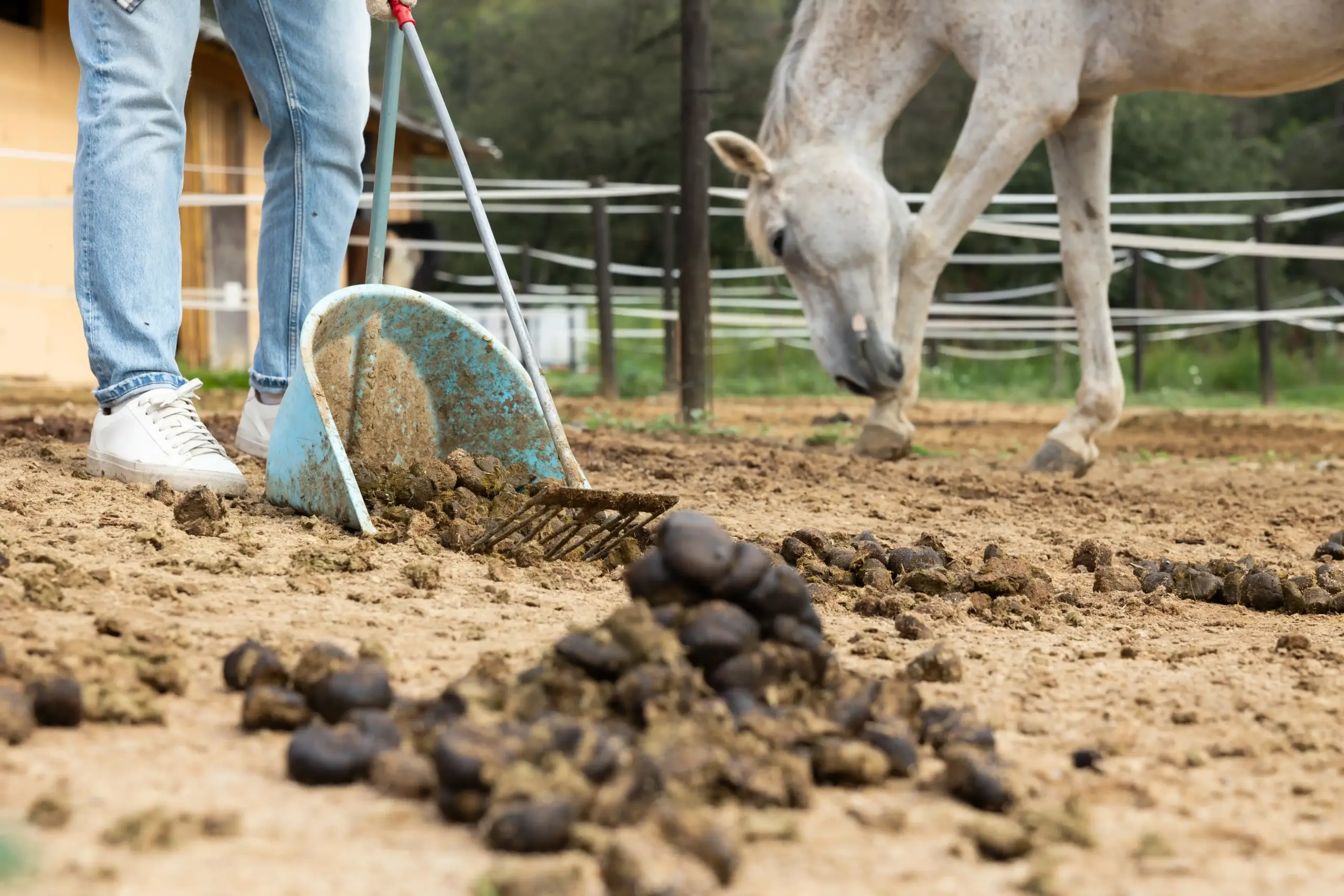
© Adobe Stock / JackF
Alternative solutions: mechanical assistance
Before investing in fully automated systems, consider simpler mechanical aids. For wheel/yard loaders, the market offers a range of attachments that can help with mucking out open barns—for example rubber scrapers for pushing muck into windrows and buckets for lifting and removing larger volumes.
The ‘Mistblitz’ pasture sweeper is a proven brush/sweeper solution for hard standings. It’s suitable for sweeping fields, paddocks and open barns, as well as tacking-up areas, courtyards, and horse or cattle loose housing. These systems cost £3,000–£8,000 and offer a good balance between automation and flexibility.
Electric wheelbarrows and battery-powered pushers/scrapers can also make the job much easier. Limpar’s battery slurry and slatted-floor scraper, the SP 94, pushes muck into windrows so it can be lifted with the yard loader’s front-end bucket. These options cost £2,000–£5,000 and are very versatile. You will still be mucking out by hand, but the removal is far more efficient than with a wheelbarrow.
Planning considerations and structural requirements
If you opt for an automated system, good planning is crucial. Scraper systems require continuous, hard-surfaced passageways with sufficient fall towards the muck area. Obstacles such as drinking troughs or posts must be navigable or have dedicated cut-outs.
Vacuum systems need a complete pipe network with connection points in every loose box. The central extraction unit requires a separate, well-ventilated room and a power supply. All pipework must remain readily accessible for cleaning and maintenance.
Robotic systems need level, obstacle-free surfaces and charging stations with a power supply. For the Active Cleaner to operate, the surface must be relatively even and hard-standing. It cannot cope with deep, boot-sucking mud runs — the sort that pull your wellies off. Entrances must be wide enough, and gates high enough, for the robot to pass through.
Critical appraisal of automation
Automated muck-removal systems are technically impressive but often problematic in horse management. High upfront costs, complex maintenance and limited use cases make them uneconomical for most yards.
These systems work best in large, modern stable complexes with hard standings and minimal bedding. In traditional yards with individual stables (loose boxes), or open barns/loose housing with unpaved turnout areas and welfare-appropriate deep-litter bedding in the shelter, they soon reach their limits.
Before investing in expensive automation, consider simpler options: electric wheelbarrows, a quad bike with a trailer, or attachments for machinery you already own can make the work significantly easier. These purchases are manageable, flexible in everyday use and usually more cost-effective than full automation.
If you still intend to consider automated systems, get thorough, independent advice first and cost out all capital and running expenses realistically. The payback period is usually longer than expected, and reliance on technology can become a serious problem when things fail at critical moments.
- Automated mucking-out systems in horse stables - 22. October 2025
- Watering systems in horse stables - 22. October 2025
- Automated hay feeding in the stable - 22. October 2025

